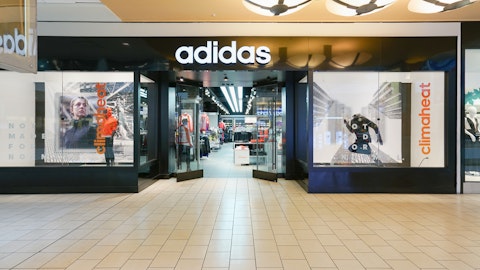Jim Swanson: Yes. Thanks, Laurent.
Operator: Up next we have Mitch Kummetz with Seaport Research. Please proceed.
Mitch Kummetz: Yes. Thanks for taking my questions. Maybe just a continuation on the gross margin discussion. So you expect it to be up 60 bps for the year. I would imagine that better freight has a big impact on that. So is there any way, Jim, you could just kind of walk us through the year-over-year impact in timing of the freight improvement that you expect to see over the course of 2023?
Jim Swanson: Yes. We — just big picture, Mitch. We’ve been looking back at 2022, inbound freight had nearly a 200 basis point — 170, 180 basis point impact unfavorably to our gross margin. Part of 2021, the tail end of 2021 was also impactful from an unfavorable standpoint. So the weight of the inbound freight is probably a little bit more heavily weighted Q1, Q2, Q3, and then it will start to abate a bit in Q4 and normalize. So that’s the way I would think about that. I think the offsets to keep in mind why you’re only seeing 60 basis points of gross margin improvement relative to what those inbound freight benefits are, are the fact that we are continuing to lap the early part of last year in which the promotional environment was extremely low.
And so we anticipate that normalization. And then with the elevated inventory levels that we have and as we work through that inventory through the combination of our outlet channels and from a wholesale closeout perspective, that will have some impact on margin as well. So those are effectively the two major offsets to the inbound freight benefit.
Mitch Kummetz: Okay. And then secondly, on the late deliveries, the delays — delivery delays and order cancellations that kind of became of that. Is there any way to either kind of quantify the impact that, that had on the fourth quarter or maybe back half combined? Or maybe better yet, I mean, as you lap that, and I think, Tim, you said that you’re not expecting any order delays or any real cancellations for Fall 2023 as you lap those delays with an order book that doesn’t have cancellations to it. Is there any way to kind of quantify kind of what you pick up as you lap that kind of easy comparison?
Jim Swanson: Well, I think the easiest way to think about it in terms of the incremental cancellations that we incurred above and beyond what we expected. I think if you just look at the high end of the revenue guidance that we provided in October relative to where we landed. The delta there is going to be entirely related to cancellations in North America across our US and Canada business. Aside from that, trying to quantify the full effect of cancellation, it’d be tough to get that into that level of detail, obviously you’re seeing in the inventory balance because by and large, the increase in our inventory is effectively that cancellations plus to some degree, earlier receipt of our spring inventory. And then as we get into this next year, Mitch, we’re planning for kind of more of a normalized shipping pattern knowing that from a supply perspective, as Tim touched on, we’re in much better shape going into 2023 now.
Mitch Kummetz: Okay. Thanks. Good luck.
Operator: Okay. The next question is coming from Paul Lejuez with Citigroup. Paul, please proceed.
Tracy Kogan: Hey, thanks. It’s Tracy Kogan filling in for Paul. My two questions. I guess the first is on your inventory. If you could just give us a little more detail there on where you think you have too much in terms of brands and categories? And then I guess, secondly, what are you seeing on the AUC side for this year, the product costing side? And are you expecting any additional price increases? Thanks.
Tim Boyle: Yeah, I’ll let Jim talk about the specifics around the inventory, but I can tell you maybe begin with the costing expectations. About half of our inflationary pressure was inbound freight. So we’ve seen healthy degree of moderation. In fact, even rollbacks costs there. So that’s a tailwind for us. Additionally, there appears to be a moderation in these cost increases we were experiencing in raw materials in the components of our products. Labor rates have also increased some substantially, but those are not going to roll back. So, I think our expectations are that the price increases at the higher rate that we saw them in 2021 and 2022 will moderate, and there’ll be some opportunity for us to expand our gross margins as we’ve guided. Jim can talk a little bit about the components of the current inventory.
Jim Swanson: Yeah. Tracy, to talk through the composition of inventory a bit. And certainly, we’re more elevated than where we ordinarily like to be from an inventory perspective. I think when you get under the hood of our inventory and look at the actual composition of the inventory, we’re still comfortable with overall quality. There’s certainly more of it, but by and large, the predominant side of it, its current future season-based inventory, we’re much earlier received on the spring season. We are carrying over a fair amount of inventory as we’ve previously spoken about. There’s a large proportion of our product lineup that is evergreen product that carries over season to season. And much of that has been offered as part of our Fall 2023 product mix that we’ve sold into our wholesale customers.
So we’re in good shape as it relates to having sold in a lot of that inventory already. And then to the degree there is aged or excess inventory that’s remaining, we’ve adjusted our inventory buys for our outlets and shifted that back more towards moving through excess and liquidation as opposed to made for product. And then more specifically around composition of inventory, the focal point in terms of where we’re seeing the growth in that is predominantly in North America. And I think that’s a good thing in that we’ve got — that’s where we’ve got the greatest ability from an outlet perspective to be able to move through that inventory profitably.
Tracy Kogan: Great. Thanks very much.
Operator: The next question is coming from Mauricio Serna with UBS. Please proceed.
Mauricio Serna: Hi. Good afternoon. Thanks for taking my questions. I just wanted to ask if we could get maybe a little bit more detail on the US growth expectation for the first quarter, maybe in terms of the wholesale versus D2C. What are you seeing also like in the D2C trends of your business so far? And maybe you could provide a little bit more detail on the rationale of what cost you guys to take that impairment charge on the prAna business? Just a little more detail on that would be very helpful. Thank you.
Tim Boyle: Yes, certainly. Well, when I think about the first half of 2023, I’m mindful that we had some of our largest customers had almost no Columbia inventory in their stores during the first several months of 2022. Our deliveries were that impacted. So the expectations are that we’ll have a nice solid Q1 few of these stores up to where they should be, and we’ll have a good start up to Q3. Our DTC growth should be solid as well. Although if you remember, we’re really focused on being a wholesale company. So we don’t give a lot of detail around a normal retailer would give. It’s just not as much a focus for the company as the wholesale portion of the business. And then as it relates to the rationale of the prAna business, we’re very bullish on the prAna brand.
And as you know, we talked a lot about the reset going on in their product. We just believe it’s taking longer than we anticipated and wanted to make sure that we were prepared to give ourselves the time to turn that brand around.
Jim Swanson: Yes. And I’d just add, there’s a lot of factors that go into the impairment. Some of it is what Tim is describing in the form of the brand’s underperformance in our minds relative to the plan that we set upon acquisition. And then to a degree, looking at market multiples, looking at interest rates, certain of those factors have also influenced the impairment charge that we took in the quarter.
Mauricio Serna: Got it. Thank you very much.
Operator: Okay. The next question is coming from Alex Perry with Bank of America. Please proceed.





